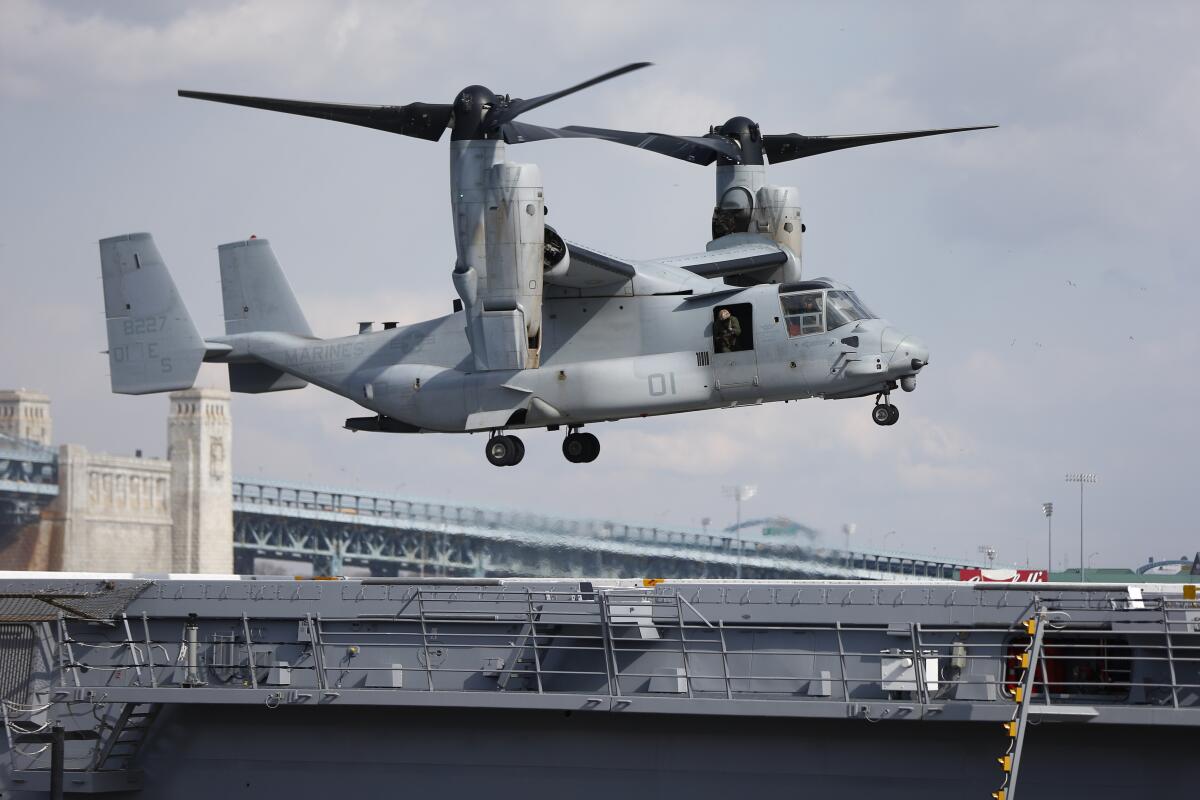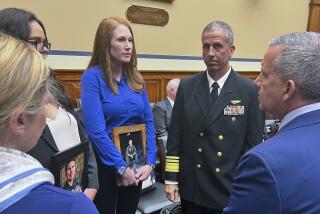Congress launches investigation into Osprey program after deadly crash in Japan

- Share via
WASHINGTON — A congressional oversight committee has launched an investigation into the V-22 Osprey program following a deadly crash in Japan that killed eight Air Force special operations service members.
The entire Osprey fleet remains grounded following the Nov. 29 crash with the exception of limited Marine Corps flights in emergencies. More than 50 U.S. service members have died in Osprey crashes over the life of the program, and 20 of those died in four crashes over the last 20 months.
The Osprey is a fast-moving airframe that can fly like both a helicopter and an airplane — but its many crashes have led critics to warn it has fatal design flaws.
The government of Japan, the only international partner flying the Osprey, also grounded its aircraft after the Nov. 29 crash.
After delays, the U.N. Security Council adopts a watered-down resolution calling for immediately speeding up aid deliveries to civilians in Gaza.
On Thursday, the U.S. House of Representatives Committee on Oversight and Accountability sent a letter to Defense Secretary Lloyd Austin requesting a massive amount of documentation on the Osprey’s safety record to be delivered to the committee by Jan. 4.
“Our servicemembers remain in harm’s way without resolution of known mechanical issues, ” wrote the committee chairman, Kentucky Republican James Comer. “While, statistically, the Osprey is not considered as dangerous as some other military aircraft, the Committee remains alarmed that most fatalities involving the aircraft have happened during training exercises, not combat operations.”
On Friday, Sens. Ed Markey and Elizabeth Warren, and Rep. Richard Neal, all Massachusetts Democrats, also announced they were pressing Austin for answers on the Osprey’s safety record. The three lawmakers represent the home state of Staff Sgt. Jacob Galliher, one of the eight Air Force special operations service members killed in the Japan crash.
“We urge the Defense Department, and the Departments of the Air Force and the Navy to ensure that the V-22 Osprey is safe to fly before allowing servicemembers from across the Commonwealth and the United States back on board,” the lawmakers wrote.
The Osprey only became operational in 2007 after decades of testing. Since then, it has become a workhorse for the Marine Corps and Air Force Special Operations Command, and was in the process of being adopted by the Navy to replace its C-2 Greyhound propeller planes, which transport personnel on and off aircraft carriers at sea.
Shortly after the Nov. 29 crash, the Air Force said that a malfunction of the aircraft, not a mistake by the crew, was probably the cause. If that is the case, it will be the second known fatal crash caused by a mechanical problem with the aircraft in a year.
The Osprey is produced through a partnership between Bell Textron and Boeing. Both companies have declined to discuss the most recent crash, but have said they will work with the military to support its investigation.
All three versions of the Osprey — the Marine Corps’ MV-22, the Air Force’s CV-22 and the Navy’s CMV-22 — are overseen by the Pentagon’s Osprey Joint Program Office.
The Joint Program Office said in a statement to the Associated Press that its engineering team has been integrated into the Air Force Special Operations Command investigation team looking at the Japan crash, and is “sharing as much information as possible without compromising the ongoing investigation to find a path forward for the V-22.”
The Osprey has faced persistent questions about a mechanical problem with the clutch that has troubled the program for more than a decade. There also have been questions as to whether all parts of the Osprey have been manufactured according to safety specifications and, as those parts age, whether they remain strong enough to withstand the significant forces created by the Osprey’s unique structure and dynamics of tiltrotor flight.
Marine Corps Ospreys also have been used to transport White House staff, press and security personnel accompanying the president. White House National Security Council spokesman John Kirby said those Ospreys have also been grounded.
More to Read
Sign up for Essential California
The most important California stories and recommendations in your inbox every morning.
You may occasionally receive promotional content from the Los Angeles Times.











